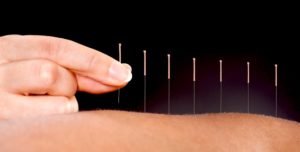Dry Needling
Dry needling seeks to relieve the pain caused by musculoskeletal dysfunction through relaxing muscle trigger points.
We offer treatment skills in the area of dry needling and use these skills in various fields, but particularly in musculoskeletal and sports therapy.
Trigger points may develop in a muscle as a result of stresses such as poor posture or repetitive actions and can refer pain and create dysfunction in other parts of the body, including severe headaches.
The process of dry needling involves a solid filament needle being gently inserted into the painful part of the muscle (the trigger point). The needle is then gently manipulated, which may produce a slightly painful “twitch response” in the muscle. After a short period, the needle is then removed. The aim is to relax or release the muscle, with the aim of permanently reducing the associated pain and discomfort and restoring the imbalances caused by the muscle feeling taut and contracted.
Compared to acupuncture, dry needling is more directly concerned with treating specific neuromuscular problems that are causing pain or hindering mobility whereas acupuncture, generally speaking, seeks to address the flow of energy around the body and vital organs by inserting needles in established meridian points on the body.
The evidence base for dry needling in various areas of physiotherapy has increased substantially over recent years. In particular, research has grown to provide evidence-based support in the treatment of acute and chronic back pain, chronic neck pain, tension type migraine headaches, pelvic girdle pain, knee osteoarthritis, lateral elbow pain and shoulder conditions.
The way it works is through complex neural pathways and chemical releases in the body. Simply put, following dry needling there is some increased blood flow to the area, endorphins (natural painkillers) are released and nerve pathways may be inhibited or to a degree blocked with the aim of helping to eases pain and promote healing.
Dry needling is a very safe and relaxing process. In some cases, a needle being inserted into a trigger point muscle can create a slight ache but many patients do not feel the needles being inserted at all. After a dry needling session, it may be that patients feel a little tired but there are no lingering effects and most people are able to continue with their day to day activities.
Many patients respond positively to dry needling almost at once, finding that the problem muscles are less taut and contracted, and clients are able to move with more freedom. In some cases, it may take a day or two for the benefits to be felt. In general, several sessions may be required to give a longer lasting benefit and for the muscle to resume functioning normally again. Usually appropriate stretching and strengthening exercises are prescribed to maintain and further improve someone’s symptoms.
Dry needling is therefore a very effective means of addressing a wide range of acute and chronic conditions that cause pain or hinder mobility, and is suitable for treating many musculoskeletal dysfunctions.
For further details please contact our Client Care Team.
Telephone: 00 973 35193767
Email: [email protected]

